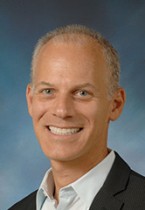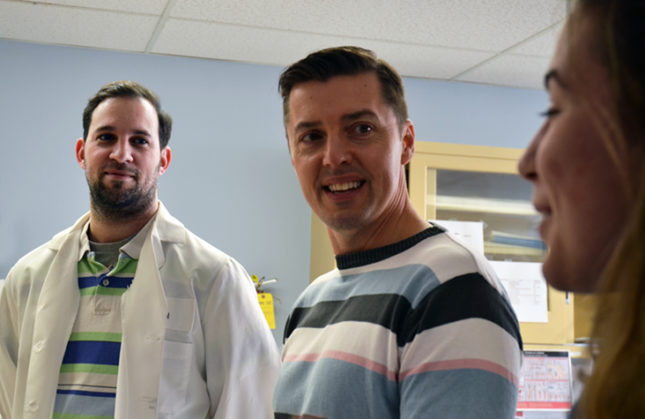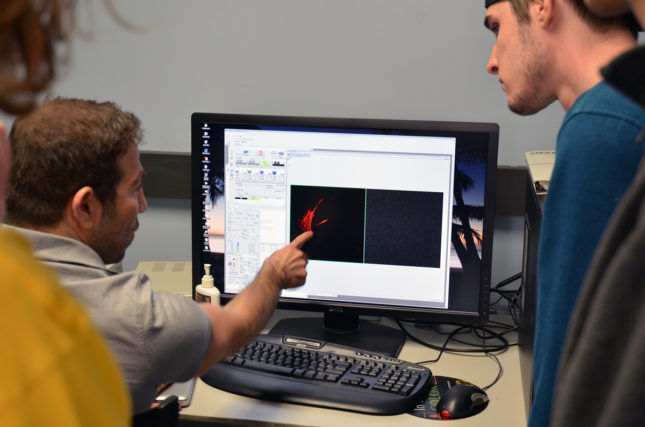
Jeff Miner, PhD
Students from St. Louis Community College – Meramec recently visited the laboratory of Jeff Miner, Professor of Medicine, Nephrology, to see research in action.
The group of 18 freshman and sophomores are students of Dr. Tom Peters, Assistant Professor in Biology at STLCC, who previously was a postdoc in the Jeffrey Milbrandt laboratory here at Washington University.
The students are part of the SEA-PHAGES (Science Education Alliance-Phage Hunters Advancing Genomics and Evolutionary Science) program. SEA-PHAGES is a Howard Hughes Medical Institute competitive grant that was awarded to only three local schools: Washington University, Webster University and St Louis Community College – Meramec. It is a two-semester, national research-based laboratory course aimed at early-career science students. Dr. Peters team-teaches the course with Dr. Bob Harms, Chair and Full Professor of Biology at STLCC.

Tom Peters, center.
Students from over 80 participating U.S. colleges and universities isolate and characterize bacteriophages (viruses that infect bacteria). The viruses are culled from soil from a variety of local environmental sources. Using various microbiological techniques, the students isolate, purify and amplify the viruses in the laboratory.
The morphology of the purified phages is examined using electron microscopy, and the phage DNA is purified and sequenced. Students then use bioinformatics tools to annotate the genome (i.e. assign genes and functions).
The main reason for the trip to Washington University was for the students to use the electron microscope to examine the viruses they had purified. A friend of Dr. Miner, Dr. Peters had some of the students visit the Miner lab while others were using the electron microscope in the lab of Dr. Wandy Beatty, Assistant Professor of Medicine in the Department of Molecular Microbiology.
Meei-Hua Lin, PhD, Steven Funk, PhD, and Hani Suleiman, MD, PhD, from the Miner lab, talked about their research and demonstrated procedures for the students.
 Dr. Lin showed the students how to culture hybridoma cells and demonstrated frozen tissue sectioning. She enjoyed talking to such a curious and responsive crowd. “They asked a lot of questions and really appreciated seeing how experiments they learned about in class were actually performed in the lab.”
Dr. Lin showed the students how to culture hybridoma cells and demonstrated frozen tissue sectioning. She enjoyed talking to such a curious and responsive crowd. “They asked a lot of questions and really appreciated seeing how experiments they learned about in class were actually performed in the lab.”
“The students were very excited and interested to see know how we work in the lab,” says Dr. Funk, who showed them how to perform an ELISA and demonstrated live immunostaining/ immunofluorescence visualization of plucked hair follicles. “They were incredibly inquisitive about the applications and diseases we study. It was delightful to share information with such a receptive audience!”
 The students observed the expression of fluorescent actin in podocytes in a demonstration by Dr. Suleiman. “They were enthusiastic about the techniques used for imaging, such as the various fluorescent proteins that help us image cultured cells using the confocal microscope.”
The students observed the expression of fluorescent actin in podocytes in a demonstration by Dr. Suleiman. “They were enthusiastic about the techniques used for imaging, such as the various fluorescent proteins that help us image cultured cells using the confocal microscope.”
The students seemed to enjoy the demonstrations, as well. Uthman Oyebamiji, Clinical Diagnostics major at Meramec, said, “It was great to see what we’ve been learning about in class applied in the lab.” Ahmed Baqalaql, who is majoring in Biomedical Engineering, said “It’s amazing!”
Co-teacher of the course, Dr. Harms, says, “Our students were able to see the microscopic bacteriophage they isolated and purified over the last 12 weeks of school from soils around our campus. Through our EM photos, we identified many new myoviridae and siphoviridae. An opportunity for this collaboration with our community college students opens up so many possibilities for their futures as biology majors.”
Dr. Peters was pleased that his students had a chance to visit the Miner lab. “Our community college biology majors had the incredible opportunity to see how what they read and study applies to real life in Dr. Miner’s renal lab. Having students tour through a real medical research facility and see what their early studies could lead to is priceless and incredibly appreciated. We look forward to further collaboration between schools in St Louis that offer this SEA-PHAGES work with Howard Hughes Medical Institute.”